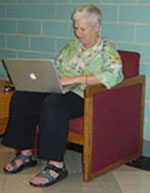
 |
In "Thinking about Multimodality," Takayoshi, Hawisher, and Selfe (2007, p. 7) write that, instead of being a new way to approach writing, multimodality actually "has been encouraged over a much longer historical period by the advent of various nondigital technologies: engraving, film, photography, recording devices, animation, and television." As such, to those worried that multimodal composition strategies may just be a "passing phase", the authors argue that multimodality has been here all along; to borrow from Bolter, it has just been "remediated." And that remediation comes thanks to "the converging inventions of personal computers and the web; photo manipulation, audio-editing, and video editing applications; and digital recorders", all which "now make it possible for students in many schools to produce a variety of multimodal texts as well as to consume them" (Takayoshi, Hawisher, & Selfe, 2007, p. 7).
If, as Bolter (2001, p. 26) argues, the purpose of remediation is to improve upon existing technology, then opening students' "writing space" to multimodal approaches seems a door to best practices. "Why," Bolter (2001, p. 107) asks, "should a writer be forced to produce a single, linear argument or an exclusive analysis of cause and effect, when the writing space allows a writer to entertain and present several lines of thought at once?". Furthermore, to paraphrase Dunn (2001, p. 29), when will writing teachers realize that not there are "ways of knowing" and communicating meaning beyond the alphabetic?. To leave the door to multimodal composition unopened is to miss out on the myriad possibilities just waiting for discovery in those rarely traveled or yet-to-be-traveled places--our very places of learning, speaking, collaborating, inventing, knowledge-making, and writing.